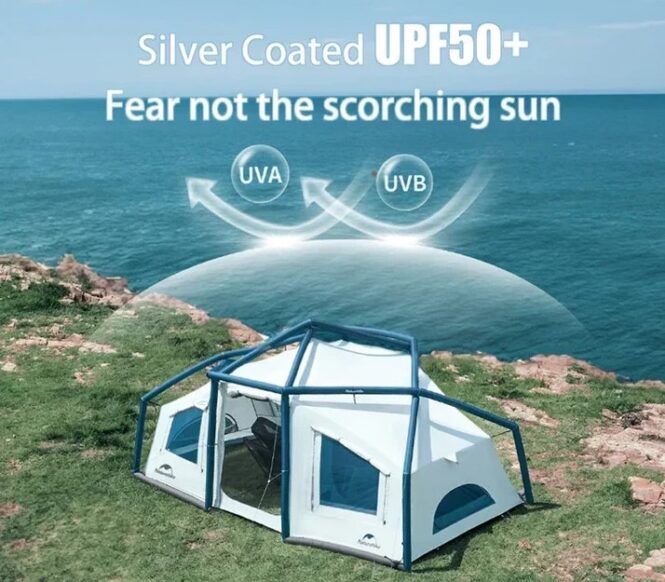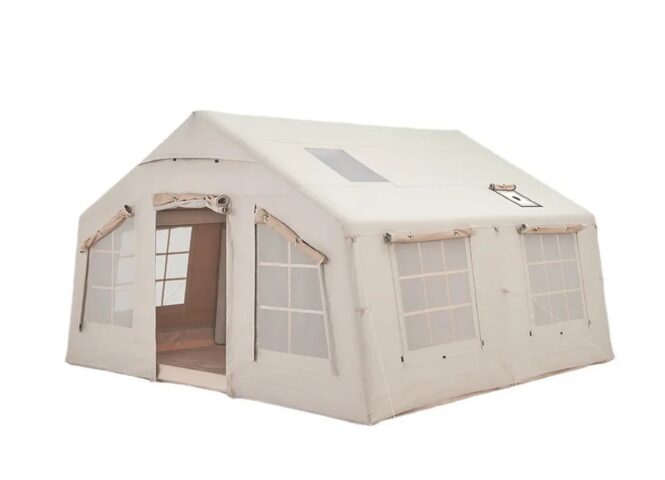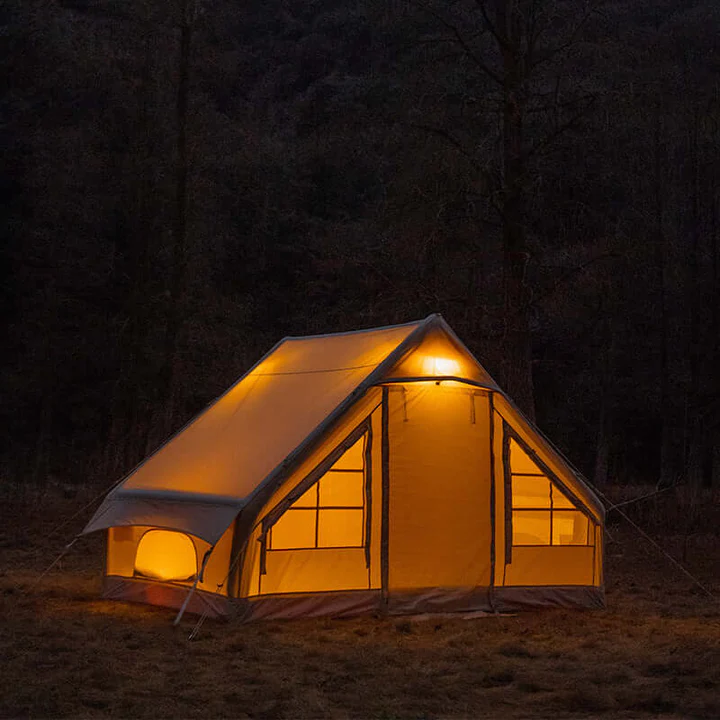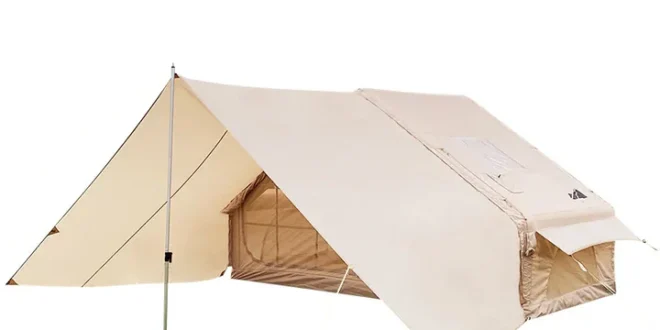Finding the right tent can make or break your outdoor experience. An inflatable tent combines convenience, durability, and ease, allowing you to focus on what matters—exploring the great outdoors.
But with so many options, making a choice can feel overwhelming. Let’s simplify it and guide you through the process step by step.
Key Points
- Choose weatherproof designs to withstand unpredictable conditions.
- Pick a size that suits your group and gear.
- Opt for high-quality materials to ensure comfort and durability.
- Test your tent before your first trip.
- Compare models to balance budget and features.
1. Why an Inflatable Tent Should Be Your Next Buy
Modern camping isn’t about struggling with poles or complicated instructions. The inflatable tent transforms how you camp. Air beams replace rigid poles, cutting setup time and hassle. It’s the ideal solution for campers seeking ease without sacrificing stability.
Key benefits:
- Fast setup ─ Spend minutes instead of hours assembling.
- Lightweight ─ Easier to transport compared to traditional options.
- Versatile designs ─ Available in various sizes to fit any group.
Practical example ─ Imagine arriving late at your campsite after a long drive. Instead of fumbling with poles in the dark, you inflate your tent in minutes, leaving you time to enjoy a campfire or relax under the stars.
2. Focus on Weather Resistance

No one wants to wake up in a soggy tent after an unexpected downpour. Weather resistance is non-negotiable. Look for waterproof materials, taped seams, and windproof structures.
Pro tips for weatherproofing:
- Check hydrostatic ratings ─ A higher number means better water resistance. Look for at least 3,000mm for reliable protection.
- Secure the tent ─ Use guy lines and stakes for added stability.
- Pack a repair kit ─ Fix minor leaks or tears quickly.
Investing in a tent with high-grade materials ensures you stay dry and safe, no matter the conditions.
3. Size Matters—But So Does Layout
A spacious tent doesn’t always mean practical. Size and layout determine comfort. Picking the right configuration ensures you maximize the space without carrying unnecessary bulk.
Things to evaluate:
- Sleeping capacity ─ Match the number of occupants. Add one extra person for gear storage.
- Separate rooms ─ For families or groups, multiple compartments offer privacy.
- Height ─ Standing room adds comfort, especially for extended stays.
Practical example ─ A couple with gear can enjoy a two-person model, while a family of four benefits from a larger option with dedicated sleeping areas.
4. Setup Speed Makes a Difference
The beauty of inflatable tents lies in their quick and simple setup. Gone are the days of struggling to fit poles into tight sleeves. Instead, air pumps do the job.
Recommendations:
- Electric pump ─ Cuts inflation time in half, ideal for larger setups.
- Manual pump ─ Lightweight and portable, perfect for small models.
- Test it first ─ Practice inflating and deflating to ensure you’re prepared.
Pro tip ─ Bring a backup pump in case your primary one fails during a trip.
5. Materials Define Comfort and Durability

The materials used in your tent determine its longevity and comfort. Look for high-quality fabrics that can withstand wear and tear.
Key features to evaluate:
- Ventilation ─ Mesh windows prevent condensation and allow fresh air circulation.
- Insulation ─ Thick materials help maintain temperature, especially in colder weather.
- Groundsheet durability ─ Reinforced floors protect against punctures and moisture.
Recommendation ─ Ripstop fabrics provide extra resistance to tears, making them ideal for rugged terrains.
6. Budget Without Compromise
Budget plays a big role in decision-making. However, going for the cheapest option may lead to regrets. Focus on value for money instead of just price.
Tips for budgeting:
- Prioritize features ─ Decide what you need most (size, weather resistance, etc.).
- Wait for sales ─ Off-season discounts offer significant savings.
- Compare models ─ Read reviews and check ratings for the best options in your price range.
Practical example ─ Spending a bit more upfront on a durable model saves money in the long run by avoiding frequent replacements.
7. Test It Before the Big Trip
Testing your tent before your first outing saves time and frustration. It also helps you identify any defects or missing parts.
How to test:
- Inflate it fully in your backyard or a nearby park.
- Check seams, zippers, and valves for issues.
- Practice folding and packing it back into its bag.
Pro tip ─ Simulate real conditions by testing during rain or wind to see how well it holds up.
8. Portability Simplifies Your Journey

Lightweight and compact options are game-changers for frequent campers. Whether hiking to a remote site or packing for a road trip, portability makes life easier.
Features to look for:
- Weight ─ A lightweight model prevents unnecessary strain.
- Pack size ─ Compact designs save space in your vehicle or backpack.
- Handles and straps ─ Make carrying more manageable.
Practical example ─ A compact option lets you pack additional gear like a portable stove or extra blankets without overcrowding your car.
9. Reviews Tell the Truth
Reviews are your best friend when choosing a tent. Real-world feedback from other adventurers gives you insight into what works and what doesn’t.
What to look for in reviews:
- Comments on durability and weather resistance.
- Feedback about setup ease and portability.
- Overall satisfaction and value for money.
Pro tip ─ Verified purchases provide the most reliable information.
FAQs
1. How do inflatable tents compare to traditional options?
They offer faster setup, lighter weight, and better portability.
2. Are they reliable in extreme conditions?
Yes, many models are designed to handle wind, rain, and moderate snow.
3. Do they come with pumps?
Most include manual pumps, but electric options are often available separately.
4. How do I repair a puncture?
Use the repair kit provided. Clean the area, apply the patch, and let it set.
5. What’s the best way to store it?
Dry it completely before packing to prevent mold and mildew.
Choosing the perfect inflatable tent doesn’t have to be complicated. By focusing on key features like weather resistance, size, and materials, you can find an option that fits your needs. With the right tent, your next adventure will be unforgettable.
 Imagup General Magazine 2024
Imagup General Magazine 2024

